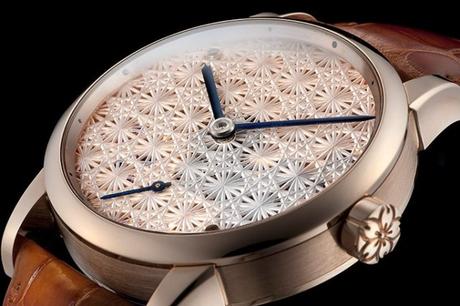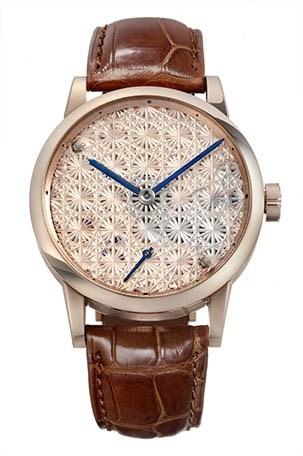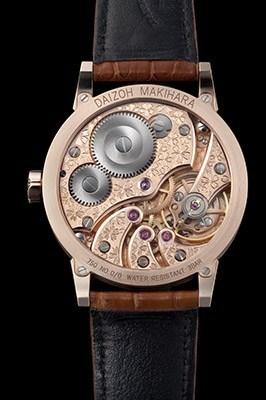Daizoh Makihara was born in Aichi, Japan in 1979. While watchmaking was already on his radar when he graduated from high school, he did not know how one becomes a watchmaker, so young Daizoh followed another path and became a cook. He worked for 8 years as a cook, specializing in Italian dishes more precisely, and, at the age 27, he enrolled in a watch making school in order to follow his old dream.
It was "the beginning of a second life" he says, and remembers that he learned how to fix his watch at this new school he was attending. At one moment, circumstances made it so that he got the chance to travel all the way to Switzerland and meet none other than Mr. Philippe Dufour, who is one of the most revered independent watchmakers of the world. His watches are regarded as the pinnacle of traditional hand-finishing and he is a symbol for the industry. Some people even call him a "living legend".
For Daizoh, meeting Mr. Dufour was, as he explains, "a turning point", as this was the moment he became sure of the fact that he wanted not only to repair watches, but to make a watch himself. Daizoh maintained a close professional relation with Mr. Dufour and says that the Swiss craftsman taught him "everything about watchmaking".

Afterwards, he took on various jobs, which included making tourbillons and he even had a teaching job at the Hiko Mizuno College of Jewelry. While working there as a teacher, he made his first watch.

One year later, in 2018, he released his emblematic watch named Kiku-tsunagi-mon sakura, or "chrysanthemum pattern cherry blossoms". The watch was a disruptive piece that got people amazed at the outstanding level of artistry and craftsmanship that was put into the watch.
The wristwatch features a hand-engraved, clear crystal glass dial, as well as a movement that were made by Daizoh himself at his workshop in the Japanese city of Saitama. The dial is made of Edo-kiriko, a traditional Japanese cut-crystal glass technique that has its origins in the18th century. Classified by the Japanese government as a traditional craft, Edo-kiriko is hand-made. There are very few people who can cut glass in Edo-kiriko, and, even fewer who can cut it so thin. Edo-kiriko is a technique used mostly for bigger pieces and Daizoh went through a lot just to find someone who believed that glass could be cut so closely - under 1 mm. But, after many trials and errors, he finally managed to find someone who could.
In terms of design, two national symbols of Japan, the chrysanthemum and cherry blossom (or sakura) are hand-engraved on the crown and also the on bridges of the movement. The case is made from 18k pink gold and is 42mm in diameter. But for Daizoh, the worth of a watch is given by its finishing (maybe something he got from Mr. Dufour?) and thus he insisted on making the most beautiful polishing possible. The collection is limited to 8 pieces, with a price of ¥5.58m including Japanese tax, which is equivalent to about US $50000. The delivery time for a watch is of 10 months.

When pondering on how his watch was received, Daizoh explains that most people were very excited to see it and open to the way he worked with Edo-kiriko, but were, above all, amazed that he was able to use the technique in such an innovative way. "I was very happy to hear that" he recalls.
Now, at the end of the decade, Daizoh is planning on widening his network by connecting with stores in Japan, but also by attending events and fairs such as Baselworld. At the moment, he is a candidate for a membership in the Académie Horlogère des Créateurs Indépendants, a Zurich-based non-profit association, founded in 1985 by Svend Andersen and Vincent Calabrese. At the moment, the AHCI has 30 members, 8 honorific members and 7 candidates.
With his skill and talent and with a lot of determination, Daizoh has the ability to take his craft and brand to much success, as he bridges the past with the future and the West with the far East, all while offering amazing timepieces which are delicate and elegant and which can be regarded as being of the highest order of watchmaking.
Fraquoh and Franchomme
P.S. We want to hear from you! What do you think of Daizoh's watches? How do you think the new Japanese culture will evolve? Why? Share your feedback, questions or thoughts in the comments below! For more articles on style, fashion tips and cultural insights, you can subscribe to Attire Club via e-mail or follow us on Facebook or Twitter!

